Evaluating Prediction Models for Mapping Canopy Chlorophyll Content Across Biomes
Abstract
1. Introduction
2. Materials and Methods
2.1. Pilot Sites
- Kytalyk (Arctic tundra) is located south of the East Siberian Sea coast, Russia (79.82°N, 147.47°E). It is part of a low-Arctic tundra nature reserve in the Indigirka lowlands. The site is characterized by very thick (>100-meter depth) ice-rich permafrost [41]. Kytalyk is a habitat of different tundra vegetation types, including tussock sedge, short shrubs, and moss tundra [42].
- La Camargue (wetland ecosystem) is one of the Ramsar sites, which is a biosphere reserve in the Rhône delta in Southern France (43.53°N, 4.50°E). The major natural habitats of La Camargue contain lagoons, brackish/freshwater marshes, halophilous scrubs, and steppes. In this ecosystem, rice and irrigated crops are predominantly intermingled with the natural wetland vegetation. Camargue is a species-rich Mediterranean wetland with more than 1200 plant species [43]. The quality and quantity of water that is available year-round highly influence the functional diversity of the pilot site. Significant parts of Camargue naturally dry up during the summer season [44].
- Bavarian Forest National Park (temperate forest) is a temperate forest found in Southeastern Germany (48.96°N, 13.39°E) along the border between Germany and the Czech Republic. The soils of the BFNP (Bavarian Forest National Park) are predominantly acid and have poor nutrient content. Loose brown, brown, and podsol brown soils are the three main soil types in the pilot site. The park is characterized by high annual precipitation (1200–1800 mm) and low temperature 3.5–6.5 °C in the valleys, 4.4–7.2 °C on the hillsides, and 2.0–5.0 °C in the higher montane zones [45]. Norway spruce (Picea abies) and European beech (Fagus sylvatica) are the two dominant tree species in the area [46].
- Lambir National Park (tropical/sub-tropical rainforests) is part of Lambir Hills National Park in Sarawak, an East Malaysian state in Borneo (4.21°N, 114.03°E). It is a lowland tropical forest with an altitude range between 150–465 meters asl. The park is mainly a dipterocarp forest mixed with some patches of heath forest [47].
2.2. Satellite Imagery
2.3. Methods
2.3.1. Selected Algorithms
- (a)
- Simple ratio vegetation indices
- (b)
- Partial least square regression (PLSR)
- (c)
- INFORM and PROSAIL radiative transfer models inversion using look-up table (LUT)The CCC products predicted by radiative transfer models (RTMs) inversion were performed by coupling the PROSPECT leaf model with two canopy models: Scattering by Arbitrarily Inclined Leaves (SAIL), and Invertible Forest Reflectance model (INFORM). The two RTMs were used to simulate and generate LUTs for non-forest and forest vegetation pilot sites’ Sentinel-2 spectra. Then merit functions applied on the LUTs to retrieve the CCC products. The essential elements of the parametrization, LUT generation, and inversion using the INFORM and PROSAIL models are described briefly below.
- (i)
- Parameterization and generation of LUT using INFORM
INFORM [27,48] is parameterized by leaf, canopy, and sensor parameters (Table 3) to generate the spectral reflectance of forests. A LUT is built by changing the inputs randomly within their range. It is always a trade-off between the size of the LUT and the computation time of the inversion. The larger the size of the LUT, the higher the chance of the simulated spectra contain all possible combinations of the input parameters, but the inversion becomes computationally expensive. Therefore, a LUT of 200,000 spectra was used, which was a recommendation of several authors [49,50]. To account for model uncertainties and reduce auto-correlation between the spectrum and input variables, a random Gaussian noise value of 0.3% was added to each simulated spectrum.- (ii)
- Parameterization and generation of LUT using PROSAIL
PROSAIL is used for the generation of the canopy reflectance spectra of ‘short vegetation’ such as wetlands, taiga, and tundra. Spectral simulation using PROSAIL requires leaf, canopy, and sensor configuration parameters. A list of the parameters used and their range based on prior knowledge in the literature are presented in Table 4.A LUT of 100,000 spectra were built by varying the inputs randomly within their range. This size of LUT has been confirmed to be large enough for retrieval of vegetation properties in different vegetation [50,51,52,53]. Similar to the INFORM spectra, a random Gaussian noise value of 0.3% was added to each simulated spectrum.- (iii)
- LUTs Inversion
- (d)
- SNAP toolbox approach
2.3.2. Assessment of Methods Transferability
- (a)
- Spatial distribution consistency
- (b)
- A measure of agreement among pairwise CCC products
- (c)
- Temporal consistency
3. Results
3.1. Spatial Distribution Consistency
3.2. The Agreement of CCC Values Predicted by the Selected Methods
3.3. Temporal Consistency
4. Discussion
5. Conclusions
Author Contributions
Funding
Acknowledgments
Conflicts of Interest
References
- Murchie, E.H.; Lawson, T. Chlorophyll fluorescence analysis: A guide to good practice and understanding some new applications. J. Exp. Bot. 2013, 64, 3983–3998. [Google Scholar] [CrossRef] [PubMed]
- Lausch, A.; Erasmi, S.; King, D.J.; Magdon, P.; Heurich, M. Understanding forest health with remote sensing-part I—A review of spectral traits, processes and remote-sensing characteristics. Remote Sens. 2016, 8, 1029. [Google Scholar] [CrossRef]
- Houborg, R.; Cescatti, A.; Migliavacca, M.; Kustas, W.P. Satellite retrievals of leaf chlorophyll and photosynthetic capacity for improved modeling of GPP. Agric. For. Meteorol. 2013, 117, 10–23. [Google Scholar] [CrossRef]
- Peng, Y.; Gitelson, A.A. Application of chlorophyll-related vegetation indices for remote estimation of maize productivity. Agric. For. Meteorol. 2011, 151, 1267–1276. [Google Scholar] [CrossRef]
- Luo, X.; Croft, H.; Chen, J.M.; Bartlett, P.; Staebler, R.; Froelich, N. Incorporating leaf chlorophyll content into a two-leaf terrestrial biosphere model for estimating carbon and water fluxes at a forest site. Agric. For. Meteorol. 2018, 248, 156–168. [Google Scholar] [CrossRef]
- Wu, C.; Niu, Z.; Gao, S. The potential of the satellite derived green chlorophyll index for estimating midday light use efficiency in maize, coniferous forest and grassland. Ecol. Indic. 2012, 14, 66–73. [Google Scholar] [CrossRef]
- Dash, J.; Curran, P.J.; Foody, G.M. Remote sensing of terrestrial chlorophyll content. In Global Climatology and Ecodynamics; Springer: Berlin/Heidelberg, Germany, 2009; pp. 77–105. [Google Scholar]
- Korus, A. Effect of preliminary and technological treatments on the content of chlorophylls and carotenoids in kale (Brassica oleracea L. var. acephala). J. Food Process. Preserv. 2013, 37, 335–344. [Google Scholar] [CrossRef]
- Zhao, C.; Wang, Z.; Wang, J.; Huang, W.; Guo, T. Early detection of canopy nitrogen deficiency in winter wheat (Triticum aestivum L.) based on hyperspectral measurement of canopy chlorophyll status. N. Z. J. Crop Hortic. Sci. 2011, 39, 251–262. [Google Scholar] [CrossRef]
- Inoue, Y.; Guérif, M.; Baret, F.; Skidmore, A.; Gitelson, A.; Schlerf, M.; Darvishzadeh, R.; Olioso, A. Simple and robust methods for remote sensing of canopy chlorophyll content: A comparative analysis of hyperspectral data for different types of vegetation. Plant Cell Environ. 2016, 39, 2609–2623. [Google Scholar] [CrossRef]
- Abdullah, H.; Darvishzadeh, R.; Skidmore, A.K.; Groen, T.A.; Heurich, M. European spruce bark beetle (Ips typographus L.) green attack affects foliar reflectance and biochemical properties. Int. J. Appl. Earth Obs. Geoinf. 2018, 64, 199–209. [Google Scholar] [CrossRef]
- Secretariat of CBD. Global Biodiversity Outlook 3; Progress Press Ltd: Malta, 2010.
- Skidmore, A.K.; Pettorelli, N.; Coops, N.C.; Geller, G.N.; Hansen, H.; Lucas, R.; Mücher, C.A.; O’Connor, B.; Paganini, M.; Pereira, H.M.; et al. Agree on biodiversity metrics to track from space. Nature 2015, 523, 403–405. [Google Scholar] [CrossRef]
- Vincini, M.; Calegari, F.; Casa, R. Sensitivity of leaf chlorophyll empirical estimators obtained at Sentinel-2 spectral resolution for different canopy structures. Precis. Agric. 2016, 17, 313–331. [Google Scholar] [CrossRef]
- Dian, Y.; Le, Y.; Fang, S.; Xu, Y.; Yao, C.; Liu, G. Influence of Spectral Bandwidth and Position on Chlorophyll Content Retrieval at Leaf and Canopy Levels. J. Indian Soc. Remote Sens. 2016, 44, 583–593. [Google Scholar] [CrossRef]
- Li, X.; Liu, X.; Liu, M.; Wang, C.; Xia, X. A hyperspectral index sensitive to subtle changes in the canopy chlorophyll content under arsenic stress. Int. J. Appl. Earth Obs. Geoinf. 2015, 36, 41–53. [Google Scholar] [CrossRef]
- Ma, M.; Shi, R.; Liu, P.; Wang, H.; Gao, W. The impacts of bandwidths on the estimation of leaf chlorophyll concentration using normalized difference vegetation indices. In Proceedings of the SPIE—The International Society for Optical Engineering, San Diego, CA, USA, 17–21 August 2014. [Google Scholar]
- Verrelst, J.; Muñoz, J.; Alonso, L.; Delegido, J.; Rivera, J.P.; Camps-Valls, G.; Moreno, J. Machine learning regression algorithms for biophysical parameter retrieval: Opportunities for Sentinel-2 and -3. Remote Sens. Environ. 2012, 118, 127–139. [Google Scholar] [CrossRef]
- Okuda, K.; Taniguchi, K.; Miura, M.; Obata, K.; Yoshioka, H. Application of vegetation isoline equations for simultaneous retrieval of leaf area index and leaf chlorophyll content using reflectance of red edge band. In Proceedings of the SPIE—The International Society for Optical Engineering, San Diego, CA, USA, 28 August–1 September 2016. [Google Scholar]
- Li, L.; Ren, T.; Ma, Y.; Wei, Q.; Wang, S.; Li, X.; Cong, R.; Liu, S.; Lu, J. Evaluating chlorophyll density in winter oilseed rape (Brassica napus L.) using canopy hyperspectral red-edge parameters. Comput. Electron. Agric. 2016, 126, 21–31. [Google Scholar] [CrossRef]
- Curran, P.J. Remote-Sensing of Foliar Chemistry. Remote Sens. Environ. 1989, 30, 271–278. [Google Scholar] [CrossRef]
- Baret, F.; Buis, S. Estimating canopy characteristics from remote sensing observations: Review of methods and associated problems. In Advances in Land Remote Sensing: System, Modeling, Inversion and Application; Springer: Dordrecht, The Netherlands, 2008. [Google Scholar]
- Darvishzadeh, R.; Skidmore, A.; Schlerf, M.; Atzberger, C.; Corsi, F.; Cho, M. LAI and chlorophyll estimation for a heterogeneous grassland using hyperspectral measurements. ISPRS J. Photogramm. Remote Sens. 2008, 63, 409–426. [Google Scholar] [CrossRef]
- Verrelst, J.; Camps-Valls, G.; Muñoz-Marí, J.; Rivera, J.P.; Veroustraete, F.; Clevers, J.G.P.W.; Moreno, J. Optical remote sensing and the retrieval of terrestrial vegetation bio-geophysical properties—A review. ISPRS J. Photogramm. Remote Sens. 2015, 108 (Suppl. C), 273–290. [Google Scholar] [CrossRef]
- Asner, G.P. Biophysical and biochemical sources of variability in canopy reflectance (vol 64, pg 234, 1997). Remote Sens. Environ. 1998, 65, 225–226. [Google Scholar]
- Gitelson, A.A.; Viña, A.; Ciganda, V.; Rundquist, D.C.; Arkebauer, T.J. Remote estimation of canopy chlorophyll content in crops. Geophys. Res. Lett. 2005, 32. [Google Scholar] [CrossRef]
- Schlerf, M.; Atzberger, C. Inversion of a forest reflectance model to estimate structural canopy variables from hyperspectral remote sensing data. Remote Sens. Environ. 2006, 100, 281–294. [Google Scholar] [CrossRef]
- Jacquemoud, S.; Verhoef, W.; Baret, F.; Bacour, C.; Zarco-Tejada, P.J.; Asner, G.P.; Francois, C.; Ustin, S.L. PROSPECT plus SAIL models: A review of use for vegetation characterization. Remote Sens. Environ. 2009, 113, S56–S66. [Google Scholar] [CrossRef]
- Colombo, R.; Bellingeri, D.; Fasolini, D.; Marino, C.M. Retrieval of leaf area index in different vegetation types using high resolution satellite data. Remote Sens. Environ. 2003, 86, 120–131. [Google Scholar] [CrossRef]
- Xie, Y.; Sha, Z.; Yu, M. Remote sensing imagery in vegetation mapping: A review. J. Plant Ecol. 2008, 1, 9–23. [Google Scholar] [CrossRef]
- Croft, H.; Chen, J.M.; Zhang, Y. The applicability of empirical vegetation indices for determining leaf chlorophyll content over different leaf and canopy structures. Ecol. Complex. 2014, 17, 119–130. [Google Scholar] [CrossRef]
- Blackburn, G.A. Quantifying chlorophylls and caroteniods at leaf and canopy scales: An evaluation of some hyperspectral approaches. Remote Sens. Environ. 1998, 66, 273–285. [Google Scholar] [CrossRef]
- Ustin, S.L.; Gitelson, A.A.; Jacquemoud, S.; Schaepman, M.; Asner, G.P.; Gamon, J.A.; Zarco-Tejada, P. Retrieval of foliar information about plant pigment systems from high resolution spectroscopy. Remote Sens. Environ. 2009, 113 (Suppl. 1), S67–S77. [Google Scholar] [CrossRef]
- Ollinger, S.V. Sources of variability in canopy reflectance and the convergent properties of plants. New Phytol. 2011, 189, 375–394. [Google Scholar] [CrossRef]
- Zheng, G.; Moskal, L.M. Retrieving Leaf Area Index (LAI) Using Remote Sensing: Theories, Methods and Sensors. Sensors 2009, 9, 2719–2745. [Google Scholar] [CrossRef]
- Chen, J.; Chen, J.; Liao, A.; Cao, X.; Chen, L.; Chen, X.; He, C.; Han, G.; Peng, S.; Lu, M.; et al. Global land cover mapping at 30m resolution: A POK-based operational approach. ISPRS J. Photogramm. Remote Sens. 2015, 103, 7–27. [Google Scholar] [CrossRef]
- Dash, J.; Curran, P.J. The MERIS terrestrial chlorophyll index. Int. J. Remote Sens. 2004, 25, 5403–5413. [Google Scholar] [CrossRef]
- Dash, J.; Vuolo, F. Algorithm Theoretical Basis Document: OLCI Terrestrial Chlorophyll Index (OTCI); University of Southampton: Southampton, UK, 2010. [Google Scholar]
- Croft, H.; Chen, J.M.; Wang, R.; Mo, G.; Luo, S.; Luo, X.; He, L.; Gonsamo, A.; Arabian, J.; Zhang, Y.; et al. The global distribution of leaf chlorophyll content. Remote Sens. Environ. 2020, 236, 111479. [Google Scholar] [CrossRef]
- Ali, A.M.; Darvishzadeh, R.; Skidmore, A.; Gara, T.W.; O’Connor, B.; Roeoesli, C.; Heurich, M.; Paganini, M. Comparing methods for mapping canopy chlorophyll content in a mixed mountain forest using Sentinel-2 data. Int. J. Appl. Earth Obs. Geoinf. 2020, 87, 102037. [Google Scholar] [CrossRef]
- Nauta, A.L.; Heijmans, M.M.; Blok, D.; Limpens, J.; Elberling, B.; Gallagher, A.; Li, B.; Petrov, R.E.; Maximov, T.C.; Van Huissteden, J. Permafrost collapse after shrub removal shifts tundra ecosystem to a methane source. Nat. Clim. Chang. 2015, 5, 67–70. [Google Scholar] [CrossRef]
- Blok, D.; Heijmans, M.M.; Schaepman-strub, G.; Kononov, A.; Maximov, T.; Berendse, F. Shrub expansion may reduce summer permafrost thaw in Siberian tundra. Glob. Chang. Biol. 2010, 16, 1296–1305. [Google Scholar] [CrossRef]
- Blondel, J.; Barruol, G.; Vianet, R. L’Encyclopédie de la Camargue; Buchet-Chastel: Paris, France, 2013. [Google Scholar]
- Dehorter, O.; Tamisier, A. Wetland habitat characteristics for waterfowl wintering in Camargue, Southern France: Implications for conservation. Revue d’écologie 1996, 51, 161–172. [Google Scholar]
- Heurich, M.; Beudert, B.; Rall, H.; Křenová, Z. National Parks as Model Regions for Interdisciplinary Long-Term Ecological Research: The Bavarian Forest and Šumavá National Parks Underway to Transboundary Ecosystem Research. In Long-Term Ecological Research: Between Theory and Application; Müller, F., Baessler, C., Schubert, H., Klotz, S., Eds.; Springer: Dordrecht, The Netherlands, 2010; pp. 327–344. [Google Scholar]
- Cailleret, M.; Heurich, M.; Bugmann, H. Reduction in browsing intensity may not compensate climate change effects on tree species composition in the Bavarian Forest National Park. For. Ecol. Manag. 2014, 328, 179–192. [Google Scholar] [CrossRef]
- Kumagai, T.O.; Saitoh, T.M.; Sato, Y.; Morooka, T.; Manfroi, O.J.; Kuraji, K.; Suzuki, M. Transpiration, canopy conductance and the decoupling coefficient of a lowland mixed dipterocarp forest in Sarawak, Borneo: Dry spell effects. J. Hydrol. 2004, 287, 237–251. [Google Scholar] [CrossRef]
- Atzberger, C. Development of an invertible forest reflectance model: The INFOR-model. Decade Trans-Eur. Remote Sens. Coop. 2001, 01, 39–44. [Google Scholar]
- Wang, Z.; Skidmore, A.K.; Wang, T.; Darvishzadeh, R.; Heiden, U.; Heurich, M.; Latifi, H.; Hearne, J. Canopy foliar nitrogen retrieved from airborne hyperspectral imagery by correcting for canopy structure effects. Int. J. Appl. Earth Obs. Geoinf. 2017, 54, 84–94. [Google Scholar] [CrossRef]
- Darvishzadeh, R.; Skidmore, A.; Abdullah, H.; Cherenet, E.; Ali, A.; Wang, T.; Nieuwenhuis, W.; Heurich, M.; Vrieling, A.; O’Connor, B.; et al. Mapping leaf chlorophyll content from Sentinel-2 and RapidEye data in spruce stands using the invertible forest reflectance model. Int. J. Appl. Earth Obs. Geoinf. 2019, 79, 58–70. [Google Scholar] [CrossRef]
- Atzberger, C.; Darvishzadeh, R.; Immitzer, M.; Schlerf, M.; Skidmore, A.; le Maire, G. Comparative analysis of different retrieval methods for mapping grassland leaf area index using airborne imaging spectroscopy. Int. J. Appl. Earth Obs. Geoinf. 2015, 43, 19–31. [Google Scholar] [CrossRef]
- Darvishzadeh, R.; Skidmore, A.; Schlerf, M.; Atzberger, C. Inversion of a radiative transfer model for estimating vegetation LAI and chlorophyll in a heterogeneous grassland. Remote Sens. Environ. 2008, 112, 2592–2604. [Google Scholar] [CrossRef]
- Atzberger, C.; Darvishzadeh, R.; Schlerf, M.; Le Maire, G. Suitability and adaptation of PROSAIL radiative transfer model for hyperspectral grassland studies. Remote Sens. Lett. 2013, 4, 56–65. [Google Scholar] [CrossRef]
- Ali, A.M.; Darvishzadeh, R.; Skidmore, A.K.; van Duren, I.; Heiden, U.; Heurich, M. Estimating leaf functional traits by inversion of PROSPECT: Assessing leaf dry matter content and specific leaf area in mixed mountainous forest. Int. J. Appl. Earth Obs. Geoinf. 2016, 45, 66–76. [Google Scholar] [CrossRef]
- Ali, A.M.; Skidmore, A.K.; Darvishzadeh, R.; van Duren, I.; Holzwarth, S.; Mueller, J. Retrieval of forest leaf functional traits from HySpex imagery using radiative transfer models and continuous wavelet analysis. ISPRS J. Photogramm. Remote Sens. 2016, 122, 68–80. [Google Scholar] [CrossRef]
- S2ToolBox Level 2 products: LAI, FAPAR, FCOVER: ATBD used to compute LAI, FAPAR and FVC, from SENTINEL2 top of canopy reflectance data that is implemented in the SENTINEL2 Toolbox. Available online: https://step.esa.int/docs/extra/ATBD_S2ToolBox_L2B_V1.1.pdf (accessed on 30 May 2020).
- Féret, J.B.; Gitelson, A.A.; Noble, S.D.; Jacquemoud, S. PROSPECT-D: Towards modeling leaf optical properties through a complete lifecycle. Remote Sens. Environ. 2017, 193, 204–215. [Google Scholar] [CrossRef]
- Yin, C.; He, B.; Quan, X.; Liao, Z. Chlorophyll content estimation in arid grasslands from Landsat-8 OLI data. Int. J. Remote Sens. 2016, 37, 615–632. [Google Scholar] [CrossRef]
- Massey, F.J. The Kolmogorov-Smirnov Test for Goodness of Fit. J. Am. Stat. Assoc. 1951, 46, 68–78. [Google Scholar] [CrossRef]
- Singh, D.; Singh, S. Geospatial Modeling of Canopy Chlorophyll Content Using High Spectral Resolution Satellite Data in Himalayan Forests. Clim. Chang. Environ. Sustain. 2018, 6, 20–34. [Google Scholar] [CrossRef]
- Asner, G.P.; Scurlock, J.M.O.; Hicke, J.A. Global synthesis of leaf area index observations: Implications for ecological and remote sensing studies. Glob. Ecol. Biogeogr. 2003, 12, 191–205. [Google Scholar] [CrossRef]
- Lee, H.S.; Davies, S.J.; LaFrankie, J.V.; Tan, S.; Yamakura, T.; Itoh, A.; Ohkubo, T.; Ashton, P.S. Floristic and structural diversity of mixed dipterocarp forest in lambir hills national park, sarawak, malaysia. J. Trop. For. Sci. 2002, 14, 379–400. [Google Scholar]
- Tieszen, L.L. Comparisons of Chlorophyll Content and Leaf Structure in Arctic and Alpine Grasses. Am. Midl. Nat. 1970, 83, 238–253. [Google Scholar] [CrossRef]
- Rocha, A.D.; Groen, T.A.; Skidmore, A.K.; Darvishzadeh, R.; Willemen, L. The Naïve Overfitting Index Selection (NOIS): A new method to optimize model complexity for hyperspectral data. ISPRS J. Photogramm. Remote Sens. 2017, 133 (Suppl. C), 61–74. [Google Scholar] [CrossRef]
- Baret, F.; Guyot, G.; Major, D.J. Crop Biomass Evaluation Using Radiometric Measurements. Photogrammetria 1989, 43, 241–256. [Google Scholar] [CrossRef]
- Ali, A.M.; Darvishzadeh, R.; Shahi, K.R.; Skidmore, A. Validating the Predictive Power of Statistical Models in Retrieving Leaf Dry Matter Content of a Coastal Wetland from a Sentinel-2 Image. Remote Sens. 2019, 11, 1936. [Google Scholar] [CrossRef]
- Sun, Q.; Jiao, Q.J.; Dai, H.Y. Evaluating the capabilities of vegetation spectral indices on chlorophyll content estimation at Sentinel-2 spectral resolutions. In Mippr 2017: Remote Sensing Image Processing, Geographic Information Systems, and Other Applications; SPIE: Bellingham, WA, USA, 2018; Volume 10611. [Google Scholar]
- Houborg, R.; McCabe, M.F. A hybrid training approach for leaf area index estimation via Cubist and random forests machine-learning. Isprs J. Photogramm. Remote Sens. 2018, 135, 173–188. [Google Scholar] [CrossRef]
- Beamish, A.L.; Coops, N.C.; Hermosilla, T.; Chabrillat, S.; Heim, B. Monitoring pigment-driven vegetation changes in a low-Arctic tundra ecosystem using digital cameras. Ecosphere 2018, 9, e02123. [Google Scholar] [CrossRef]
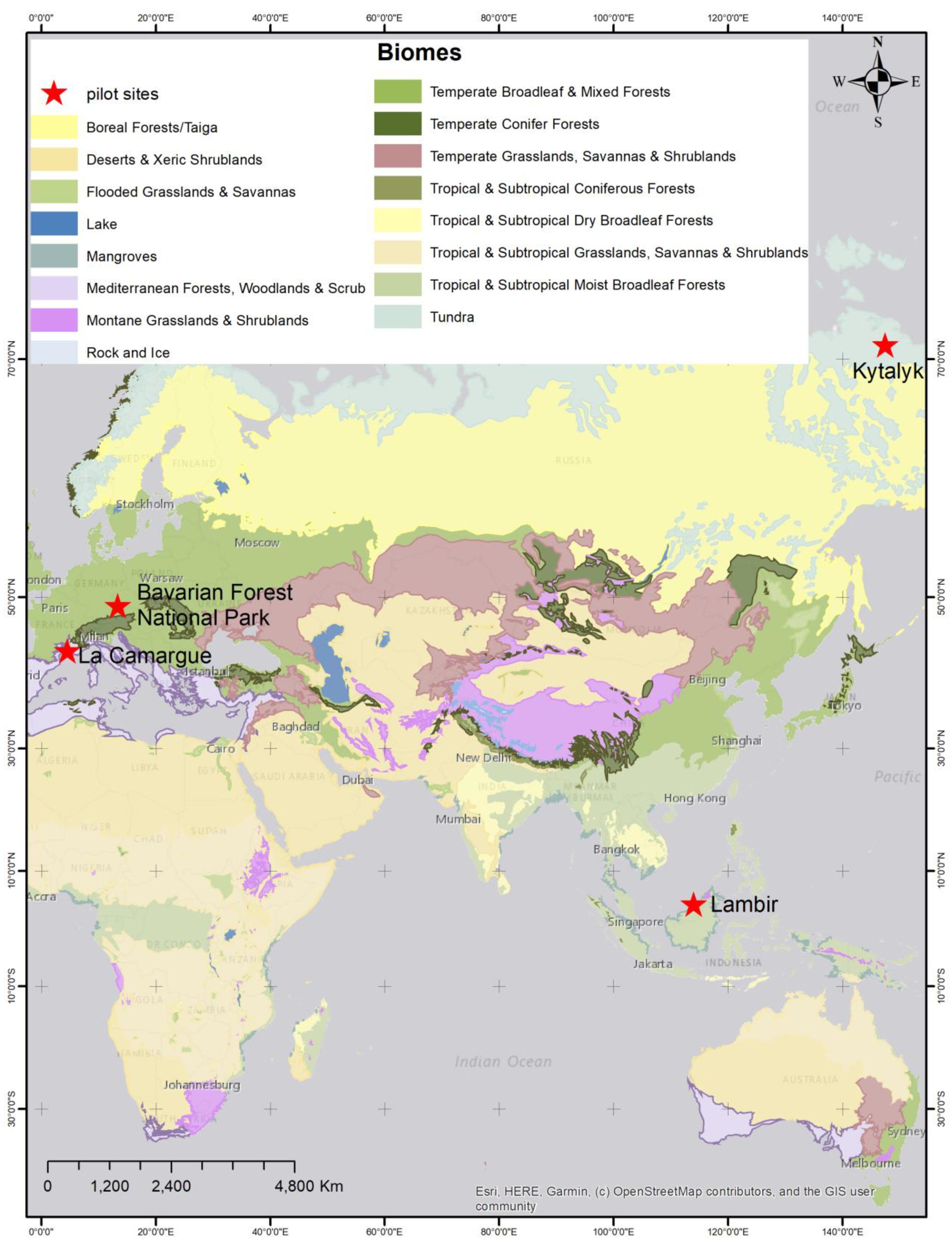
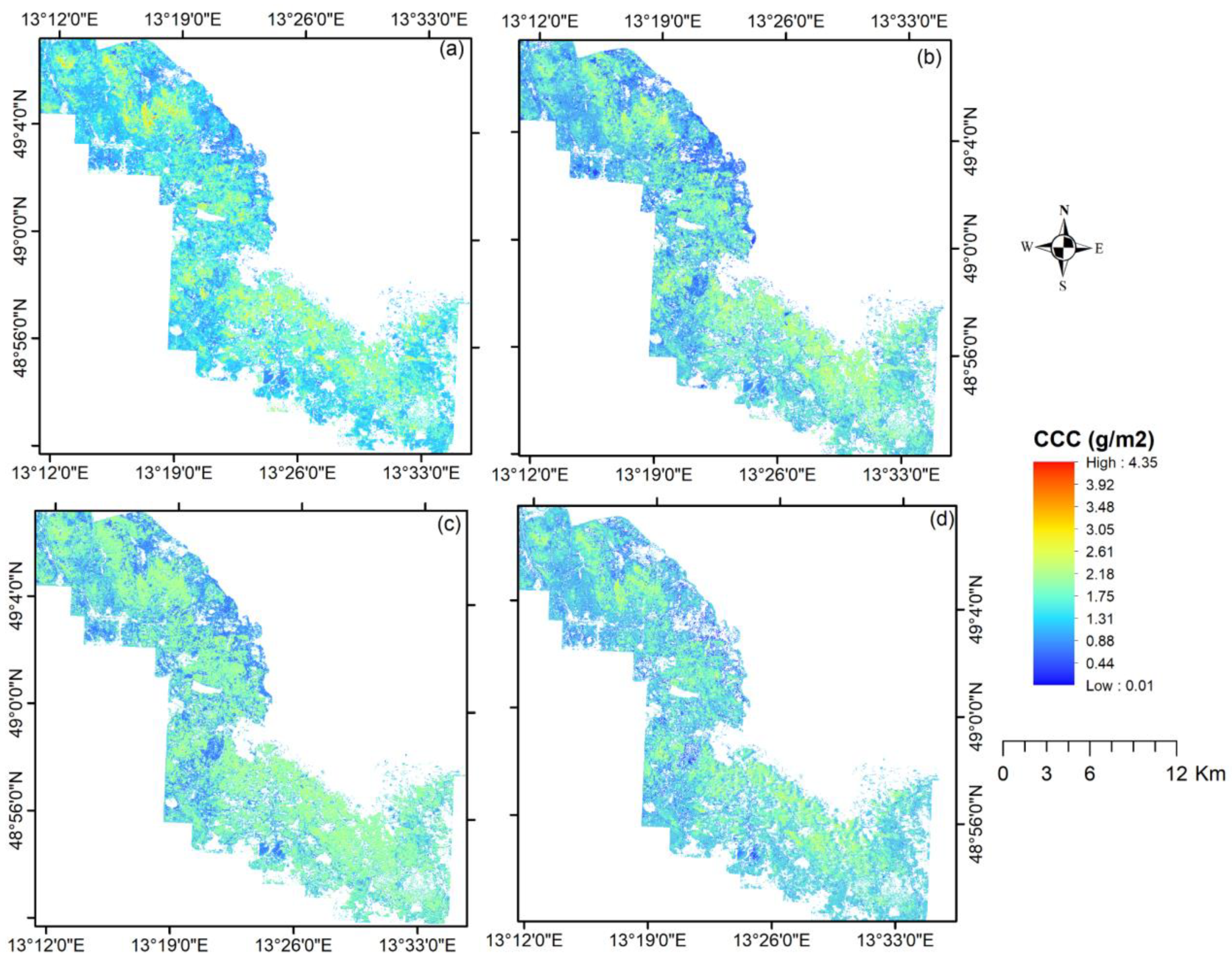


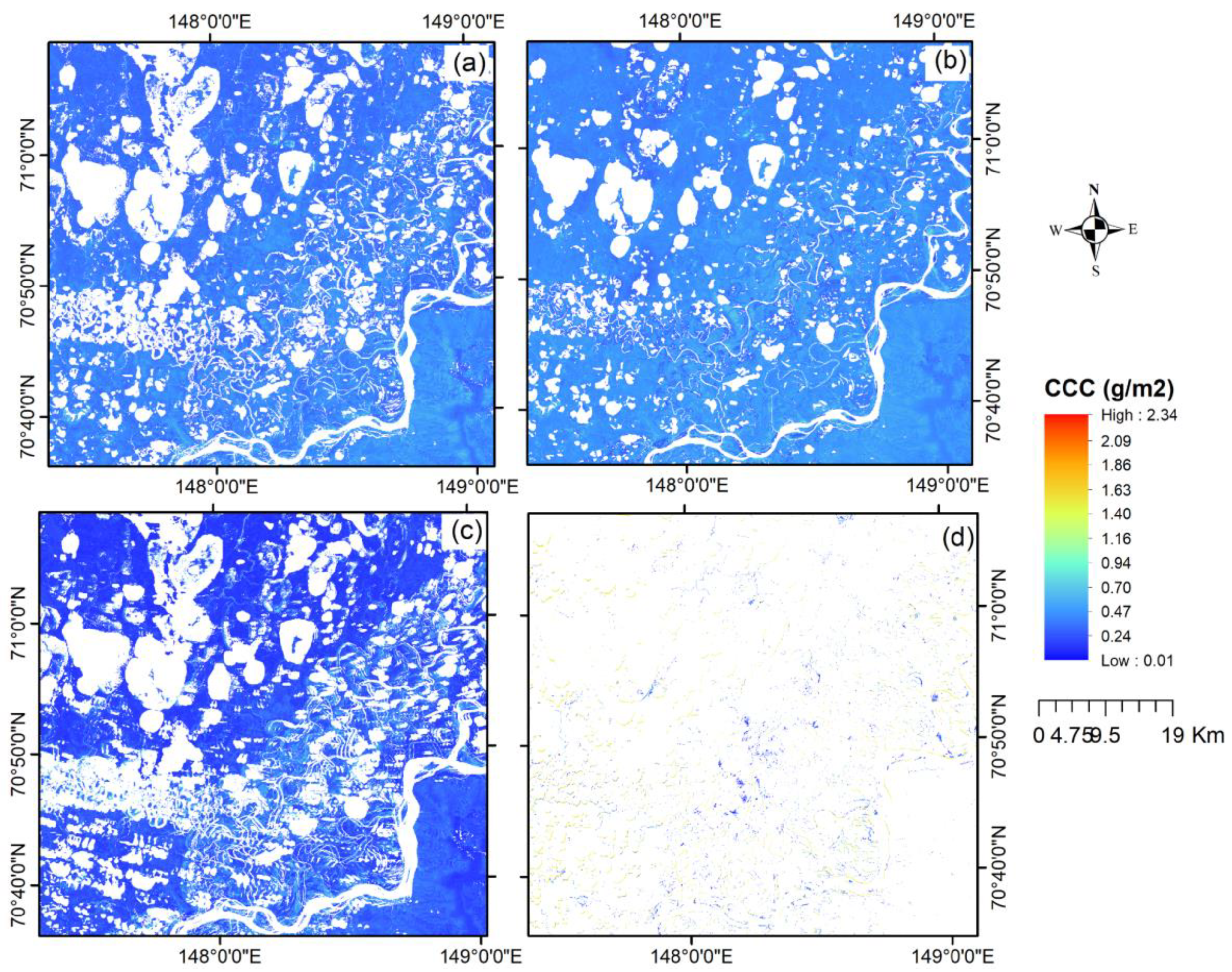
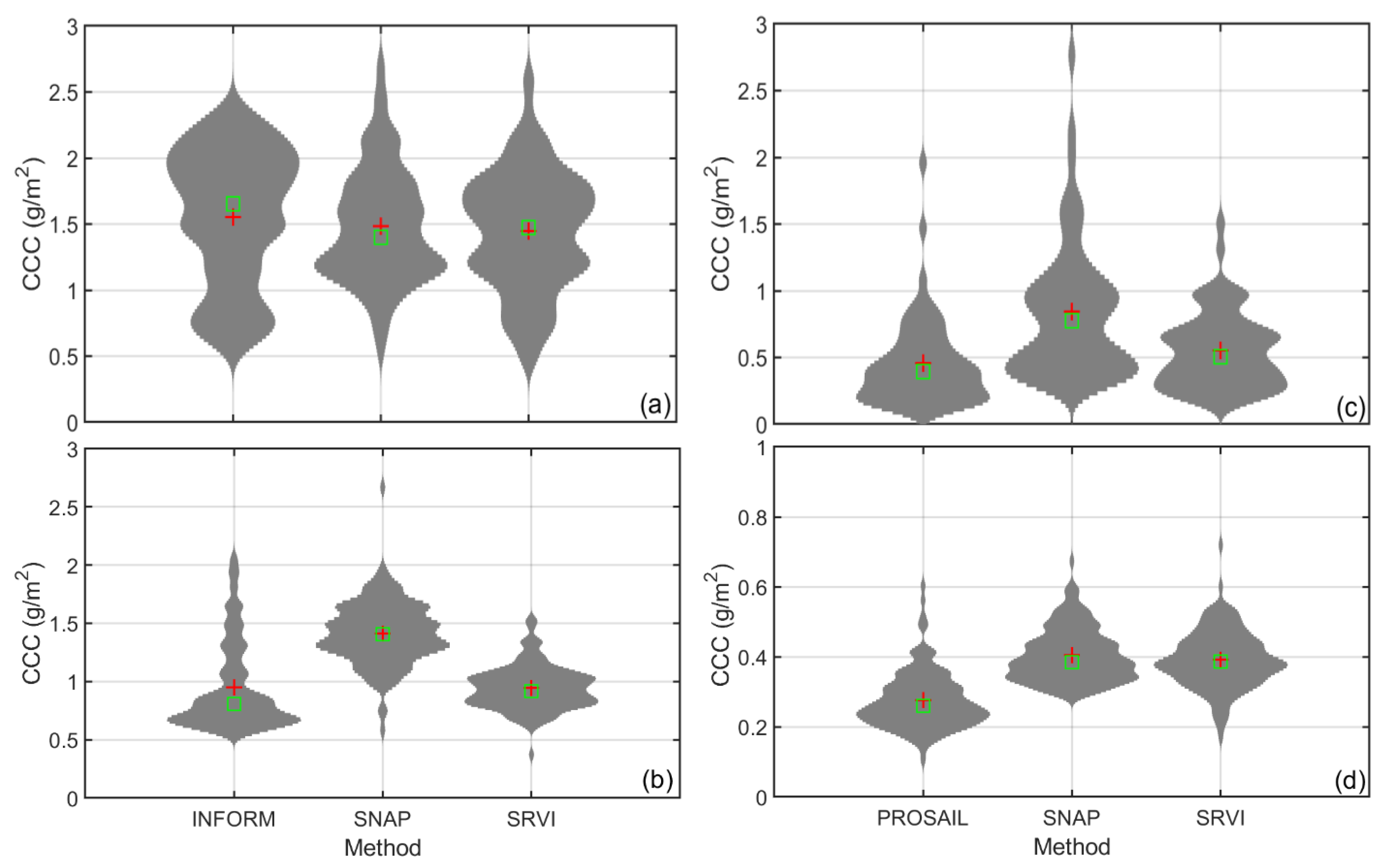
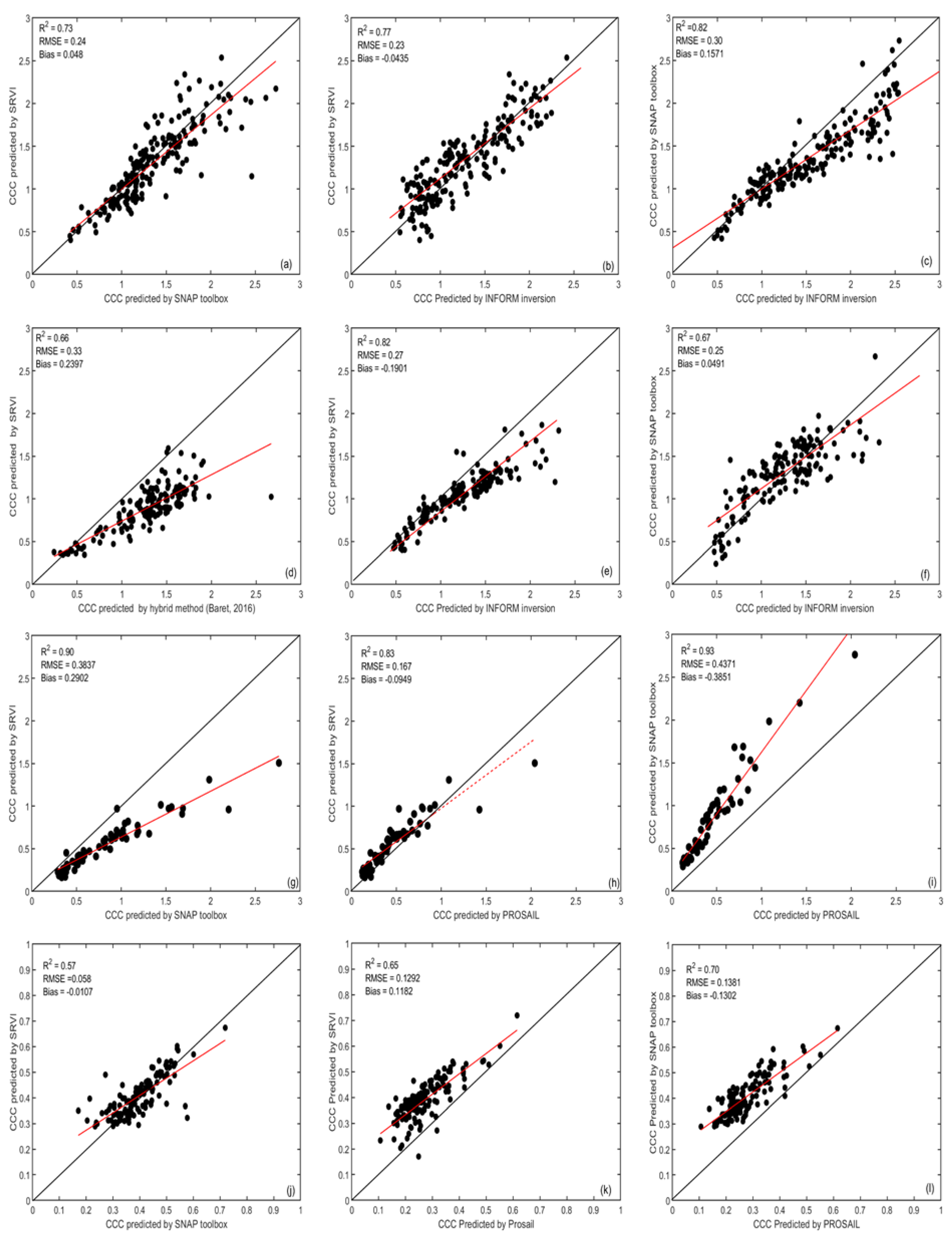
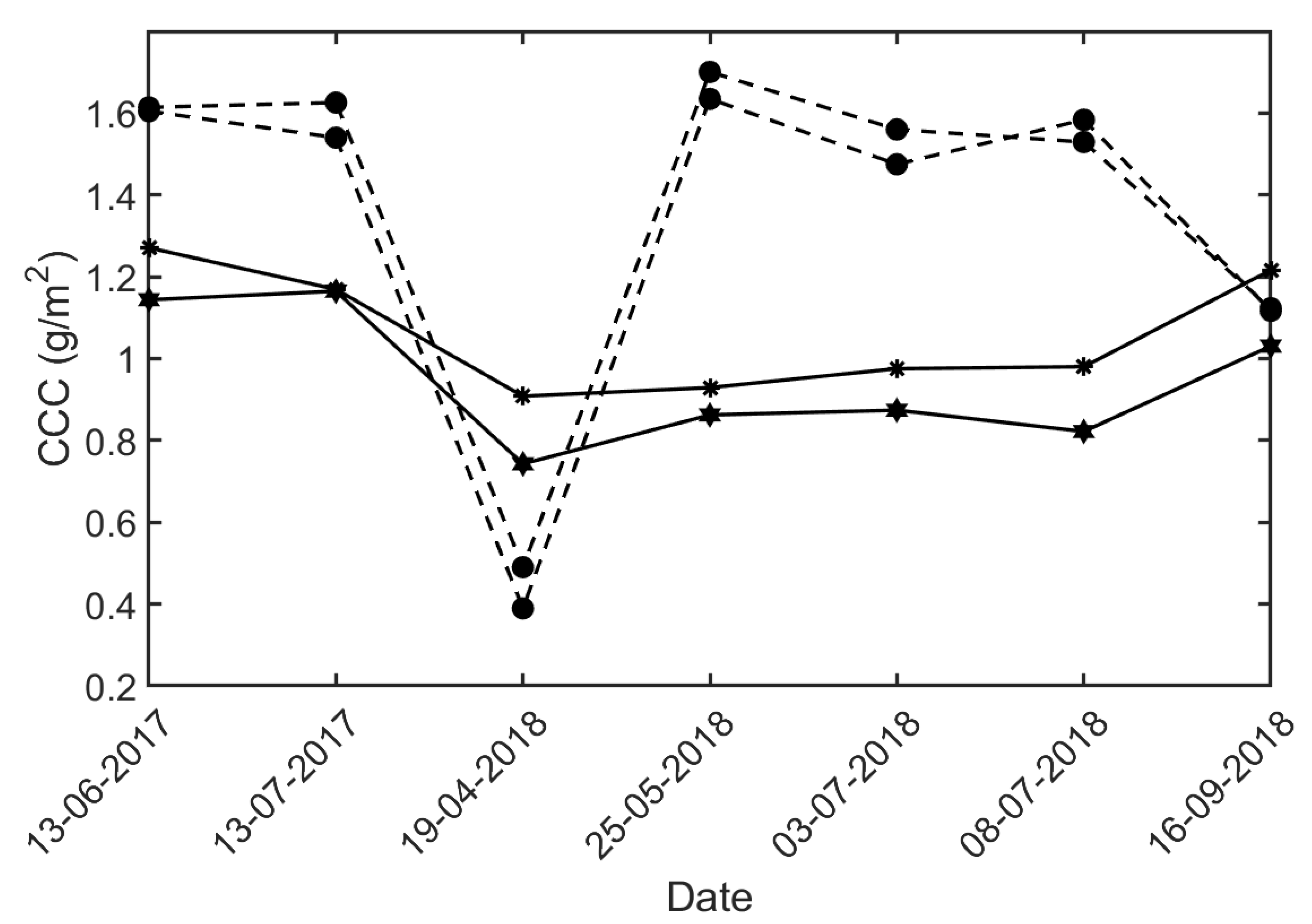


| Pilot Site | Sentinel-2 Tile Number | No. Images | Date of Acquisition |
|---|---|---|---|
| Kytalyk | T55WEU | 1 | 21 May 2018 |
| La Camargue | T31TFJ | 15 | (29 July, 18 August, 7 & 8 September, 27 October & 24 December) 2017 (26 March, 25 April, 25 May, 19 &27 June, 27 July, 16 August & 27 September) 2018 |
| Bavarian Forest National park | T33UUQ | 7 | (13 June & 13 July) 2017 (19 April, 29 May, 3 & 8 July) 2018 |
| Lambir | T49NHE | 1 | 28 June 2018 |
| Spectral Band | Function | Center Wavelength (nm) | Band Width (nm) | Spatial Resolution (m) |
|---|---|---|---|---|
| B1 | Coastal aerosol | 443 | 21 | 60 |
| B2 | Blue | 490 | 66 | 10 |
| B3 | Green | 560 | 36 | 10 |
| B4 | Red | 665 | 31 | 10 |
| B5 | Vegetation red edge | 705 | 15 | 20 |
| B6 | Vegetation red edge | 740 | 15 | 20 |
| B7 | Vegetation red edge | 783 | 20 | 20 |
| B8 | Near Infrared (NIR) | 842 | 106 | 10 |
| B8a | NIR | 865 | 22 | 20 |
| B9 | Water vapor | 940 | 21 | 60 |
| B10 | SWIR-Cirrus | 1375 | 31 | 60 |
| B11 | Short wave infrared (SWIR) | 1610 | 93 | 20 |
| B12 | SWIR | 2190 | 180 | 20 |
| Parameter | Symbol | Unit | Range or Fixed Values | Reference | |
|---|---|---|---|---|---|
| Min | Max | ||||
| Leaf dry mass per area | Cm | g/cm2 | 0.005 | 0.03 | [54] |
| Equivalent water thickness | Cw | g/cm2 | 0.006 | 0.035 | [54] |
| Leaf structural parameter | N | NA | 1 | 2.5 | [54] |
| Leaf chlorophyll content | Cab | µg/cm2 | 5 | 65 | [40] |
| Single tree LAI | LAIs | NA | 2 | 10 | [55] |
| Understory LAI | LAIu | NA | 0.2 | 1 | [40] |
| Stem density | SD | n/hr | 200 | 2000 | [55] |
| Stand height | S.H. | m | 5 | 40 | [55] |
| Crown diameter | CD | m | 3 | 10 | [55] |
| Average leaf angle | ALA | degree | 40 | 60 | [55] |
| Sun zenith angle | θs | degree | 25 | 35 | Sentinel-2 metadata |
| Observation zenith angle | θ0 | degree | 0 | 15 | Sentinel-2 metadata |
| Azimuth angle | Φ | degree | 50 | 210 | Sentinel-2 metadata |
| Scale | NA | 0.5 | 1.5 | [27] | |
| Fraction of diffused radiation | Sky1 | fraction | 0.1 | [27] | |
| Parameter | Symbol | Unit | Range or fixed Values | Reference | |
|---|---|---|---|---|---|
| Min | Max | ||||
| Leaf dry mass per area | Cm | g/cm2 | 0.003 | 0.025 | [54] |
| Equivalent water thickness | Cw | g/cm2 | 0.005 | 0.035 | [54] |
| Leaf structural parameter | N | 1.2 | 2.2 | [54] | |
| Chlorophyll content | Cab | µg/cm2 | 5 | 70 | [56] |
| Carotenoid content | Car | µg/cm2 | 8 | [57] | |
| Anthocyanin content | Ant | µg/cm2 | 0 | [57] | |
| brown pigment content | Cbrown | 0 | [57] | ||
| Leaf area index | LAI | m2/m2 | 0.2 | 8 | [56] |
| Leaf inclination distribution function type | TypeLidf | 2 | [57] | ||
| Leaf inclination distribution function a | LIDFa | degree | 20 | 70 | [56] |
| Leaf inclination distribution function b | LIDFb | 0 | [57] | ||
| Hot spot factor | Hspot | 0.5/LAI | [58] | ||
| Soil reflectance factor | psoil | 0.3 | 0.6 | [57] | |
| Sun zenith angle | ts | degree | 25 | 35 | Sentinel-2 metadata |
| Observation zenith angle | t0 | degree | 0 | 15 | Sentinel-2 metadata |
| Azimuth angle | psi | degree | 50 | 210 | Sentinel-2 metadata |
| Biome | Expected CCC Range (g/m2) | The Range of CCC Predicted by the Selected Methods | ||||
|---|---|---|---|---|---|---|
| SRVI | SNAP | INFORM | PLSR | PROSAIL | ||
| Temperate forest | 0.5–3.0 | 0.26–2.80 | 0.22–4.35 | 0.50–2.70 | 0.01–3.54 | |
| Tropical forest | 0.54–4.43 | 0.31–1.95 | 0.16–3.20 | 0.50–2.60 | 0.00–3.06 | |
| Wetland and crops | 0.0–6.0 | 0.19–2.00 | 0.03–7.16 | 0.05–2.82 | 0.08–4.12 | |
| Tundra | 0.004–0.4 | 0.32–1.64 | 0.01–2.34 | 0.03–2.08 | 0.05–1.52 | |
| Bavarian Forest National Park (Temperate Forest) | |||||||
|---|---|---|---|---|---|---|---|
| Pair of Methods | Paired t-Test | Kolmogorov-Smirnov Test | |||||
| H | p-Value | t-Stats | Sd. | H | p-Value | K Stats | |
| INFORM vs SRVI | 1 | 0.009 | 2.66 | 0.4123 | 0 | 0.0218 | 0.1982 |
| INFORM vs SNAP | 1 | 0.00 | 10.28 | 0.2461 | 0 | 0.0218 | 0.1982 |
| SRVI vs SNAP | 0 | 0.1929 | 1.31 | 0.266 | 0 | 0.6244 | 0.0991 |
| Lambir (Tropical forest) | |||||||
| INFORM vs. SRVI | 0 | 0.8894 | −0.14 | 0.357 | 1 | 0.00 | 0.3468 |
| INFORM vs. SNAP | 1 | 0.00 | 12.19 | 0.4222 | 1 | 0.00 | 0.6532 |
| SRVI vs. SNAP | 1 | 0.00 | 24.56 | 0.2116 | 1 | 0.00 | 0.75 |
| La Camargue (Wetland) | |||||||
| PROSAIL vs. SRVI | 1 | 0.00 | −5.29 | 0.1389 | 0 | 0.1034 | 0.2167 |
| PROSAIL vs. SNAP | 1 | 0.00 | −14.31 | 0.2084 | 1 | 0.00 | 400 |
| SRVI vs. SNAP | 1 | 0.00 | 8.88 | 0.2532 | 1 | 0.002 | 0.3333 |
| Kytalyk (Arctic Tundra) | |||||||
| PROSAIL vs. SRVI | 1 | 0.00 | 19.81 | 0.1172 | 1 | 0.00 | 0.91 |
| PROSAIL vs. SNAP | 1 | 0.00 | 12.19 | 0.1371 | 1 | 0.00 | 0.6911 |
| SRVI vs. SNAP | 0 | 0.0138 | −16.40 | 0.0396 | 0 | 0.3511 | 0.1119 |
© 2020 by the authors. Licensee MDPI, Basel, Switzerland. This article is an open access article distributed under the terms and conditions of the Creative Commons Attribution (CC BY) license (http://creativecommons.org/licenses/by/4.0/).
Share and Cite
Ali, A.M.; Darvishzadeh, R.; Skidmore, A.; Heurich, M.; Paganini, M.; Heiden, U.; Mücher, S. Evaluating Prediction Models for Mapping Canopy Chlorophyll Content Across Biomes. Remote Sens. 2020, 12, 1788. https://doi.org/10.3390/rs12111788
Ali AM, Darvishzadeh R, Skidmore A, Heurich M, Paganini M, Heiden U, Mücher S. Evaluating Prediction Models for Mapping Canopy Chlorophyll Content Across Biomes. Remote Sensing. 2020; 12(11):1788. https://doi.org/10.3390/rs12111788
Chicago/Turabian StyleAli, Abebe Mohammed, Roshanak Darvishzadeh, Andrew Skidmore, Marco Heurich, Marc Paganini, Uta Heiden, and Sander Mücher. 2020. "Evaluating Prediction Models for Mapping Canopy Chlorophyll Content Across Biomes" Remote Sensing 12, no. 11: 1788. https://doi.org/10.3390/rs12111788
APA StyleAli, A. M., Darvishzadeh, R., Skidmore, A., Heurich, M., Paganini, M., Heiden, U., & Mücher, S. (2020). Evaluating Prediction Models for Mapping Canopy Chlorophyll Content Across Biomes. Remote Sensing, 12(11), 1788. https://doi.org/10.3390/rs12111788









